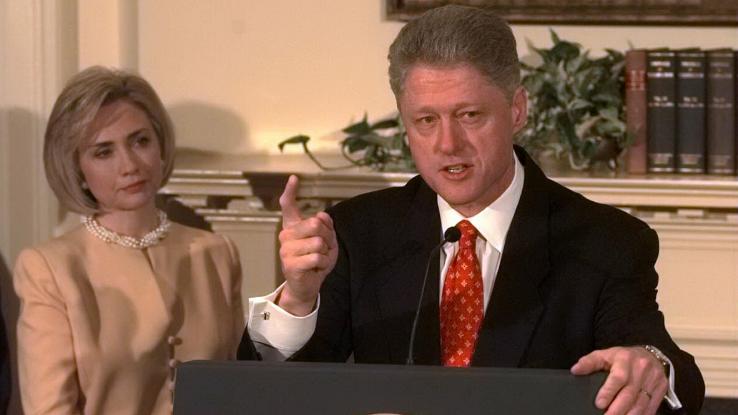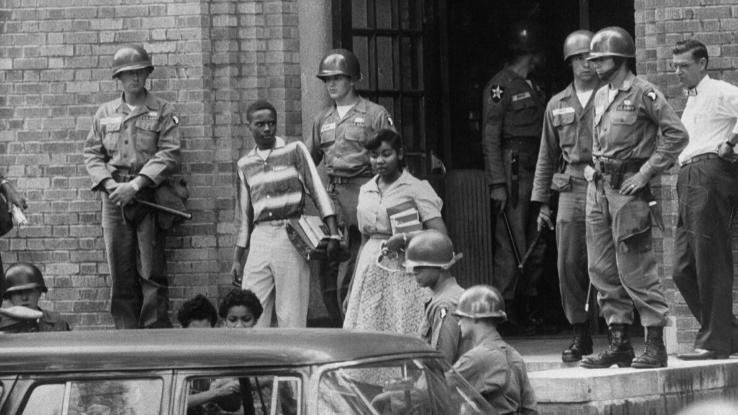Fact Check: What Power Does the President Really Have Over State Governors?

Sometimes it’s hard to distinguish fact from fiction, especially when the United States has had a complicated relationship with telling the truth. Throughout the coronavirus pandemic in particular, things have been equally confusing for everyday people when it comes to protecting themselves and others and taking action to slow the spread of the disease. With different messages about safety (or lack thereof) coming from different levels of government, it’s been difficult to determine which courses of action are the right ones and which leaders to believe. But this is just one example of the ways lines can become blurred when there are discrepancies in the recommendations and guidelines funneling down from presidents and governors.
In the past, there have been many examples of presidents overruling states and misusing their power, but governors don’t have complete and total decision-making power in regards to certain issues in their states, either. Facts can be stubborn things, but so can politicians. That’s why we’re taking a look at who’s really in charge of states in times of crisis.
The President Decides When States Can Reopen or Close During Lockdowns
Nope. The COVID-19 pandemic has seen us witness plenty of power struggles between the White House and state governors regarding lockdown orders around the country, and they serve as effective examples of different authorities attempting to gain or maintain control. For instance, in mid-April of 2020, Donald Trump stated, “They [governors] can’t do anything without the approval of the President of the United States.” He also wrote on Twitter, “For the purpose of creating conflict and confusion, some in the Fake News Media are saying that it is the governors’ decision to open up the states, not that of the President of the United States and the Federal Government. Let it be fully understood that this is incorrect….”

Trump’s statements were completely false. According to the 10th Amendment of the Constitution, “The powers not delegated to the United States by the Constitution, nor prohibited by it to the States, are reserved to the States respectively, or to the people.” This means the president only has powers that are outlined in the Constitution. As much as a president is allowed to try to intimidate governors into taking actions like reopening the states they lead in the middle of a pandemic, the president doesn’t have the legal power to alter state orders.
States adopted their own safety measures in response to the COVID-19 outbreak, but Trump threatened to “override governors” if they didn’t reopen churches or businesses. He — or any president — can’t actually order state governors to do this; it’s against the law. A president has no power to ease restrictions or shut down entire states, but governors do. And they have the power to protect the safety and health of the people in their states.
When Somebody Is the President of the United States, Their Authority Is Total
False. It’s a common misconception that the U.S. President is the most powerful person in the country and the world. Even Trump stated that the president has “total authority,” but this is fake news. Legal experts say Trump’s comment isn’t anywhere in the Constitution, and there haven’t been any provisions to the supreme law to support it.

In 1974, Richard Nixon tried to use his powers to withhold information (specifically audio tapes) from the public during the Watergate scandal. However, the Supreme Court ruled that his executive privilege didn’t protect him. Bill Clinton also tried to assert his powers in federal court after his affair with Monica Lewinsky was discovered, but it didn’t help him either. Law professor Susan Low Bloch said it best: “The president is not a king. His powers are broad, but they are definitely not ‘total.'”
The President Has No Power Over State Governors
Incorrect. The commander-in-chief can send the military to control states and state governors if the president believes they are involved in a violent uprising or rebellion against the government. This power is granted by the Insurrection Act of 1807, most famously used by Dwight D. Eisenhower to protect the Little Rock Nine on their way to school.

In 1871, Ulysses S. Grant also invoked the Insurrection Act to suppress the Ku Klux Klan in South Carolina. Federal troops were deployed by Grant again in 1872 due to racial violence across Louisiana following the gubernatorial election. John F. Kennedy sent troops to Southern states to enforce desegregation orders in public schools as well, but that wasn’t the only time he cited the act. Kennedy also ordered troops to control the Ole Miss riot of 1962 and the Stand in the Schoolhouse Door incident during the Civil Rights Movement.
The President’s Control Extends Beyond Laws
True. Despite having no authority to reopen or close states during a public health emergency such as the coronavirus pandemic, the president can still impact state governors in important ways — primarily through social influence. Whether a president’s remarks are true or false, they have powerful effects. For instance, during the beginning of the coronavirus pandemic, people who trusted President Trump looked to him for information and guidance rather than to their state governors. However, Trump had a pattern of providing false information that led to dangerous outcomes, such as suggesting the public inject themselves with disinfectants. These harmful claims can create problems that governors then have to overcome, especially during the pandemic.

While Trump downplayed the seriousness of the outbreak and politicized basic precautions meant to keep people healthy, governors took the lead in managing the spread of the virus in their individual states. Some states enforced strict stay-at-home orders and encouraged the public to wear face masks to protect themselves. However, flattening the curve required a group effort, and some people refused to comply. Instead, they followed the actions and words of the president, who refused to wear face masks for the first several months of the pandemic; didn’t practice social distancing; and rarely listened to the advice of the country’s top health experts. As a result, states had a difficult time beating the virus and keeping people safe.
Trump also failed to immediately provide ventilators, personal protective equipment and other materials to help states fight COVID-19. Instead, he advised governors to find their own lifesaving equipment, which led each state to fend for itself. Case in point? Gov. Gavin Newsom turned to Chinese companies for face masks, while Gov. Charlie Baker asked the New England Patriots’ owner to use the team’s plane to bring back supplies from China.
A president’s viewpoints can also put political pressure on state leaders. If governors don’t follow the president’s lead, supporters of that president potentially could see their governors as enemies and continue to ignore those governors’ efforts to keep people safe. Sometimes, elections are used to sway governors. For instance, President Trump suggested that he would want to see leaders run for re-election if they followed his orders, which potentially emboldened governors who weren’t acting in the best interest of public health or safety. In the early weeks of the COVID-19 pandemic, Trump also stated he was only willing to help governors of blue states if they stopped criticizing him.
These attempts at controlling governors’ actions, while transparent and manipulative, did indeed impact their behavior during a time when they were desperate for help. It ultimately showed the kind of control a president can exert without calling on laws to do so.
During National Emergencies, the President Is Given Complete Control
Mostly Untrue. It’s actually not the president or state governors who are given control during national emergencies, but Congress. Although the National Emergencies Act, the Stafford Act and the Defense Production Act give the president more power than normal during a crisis, Congress still has the final say about many things.

When President Harry Truman tried to pass an executive order to seize and shut down the country’s steel industry during a nationwide steelworkers strike, the Supreme Court blocked his efforts, arguing that Congress and the Constitution didn’t grant him the power to do so. Truman even claimed it was a matter of national security, but the Supreme Court disagreed.
However, there have been cases in the past in which presidents abused their powers and took control. In 1861, Abraham Lincoln suspended habeas corpus during the Civil War without approval from Congress. Franklin Roosevelt used emergency powers to detain more than 100,000 Japanese and Japanese-American people in internment camps during World War II — although Congress eventually implemented this order itself. However, the fact that instances exist in which presidents acted without regard to their constitutionally conferred power or to congressional authority doesn’t mean these are new standards that have been set that we must accept today.
Despite these examples, laws have been amended to check and moderate the president’s powers. When it comes to determining who has more authority between the president and state governors, it depends on the situation. However, today, the Constitution and Congress hold the highest legal authority and power to exercise the most control.





